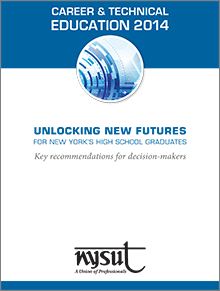
Executive Summary
Career and Technical Education (CTE) must be a high priority as our rapidly evolving global economy demands practical, relevant and multiple pathways for preparing young people for their roles in society. CTE provides a learning environment that can lead to a rigorous career-aligned contextualized learning experience. High quality CTE promotes college and career readiness in the development of academic, technical and employability skills such as communication, reasoning, problem solving, the ability to work in teams and other behaviors and skills vital to employers.
In November 2013, NYSUT convened a workgroup of New York state CTE practitioners to craft a statewide perspective on CTE issues. The group recommended six principal tasks:
1. Update CTE's Program Identity and its Benefits for All Students and the Workforce
Today's CTE is more than job training. One of the highest graduation certificates a student can achieve is a Regents Diploma enhanced with a CTE technical endorsement.
2. Strengthen Comprehensive Standards Development and Implementation
In collaboration with industry and higher education partners, review, update and align Career Development Occupational Studies (CDOS) standards to Common Core Standards and Common Career Technical Standards to focus students, teachers and parents on career goals.
3. Extend CTE Program Development and Ensure Equity and Access for All Students
Begin discussions about career exploration and education pathways with elementary and middle school students and strategically focus program development on work force needs and job growth so that students acquire skills with labor market value and postsecondary readiness.
4. Expand the Teacher Pipeline, Credentialing and Professional Learning
Recruit, certify and retain CTE teachers with up-to-date industry skills and knowledge and robust professional development to keep their skills dynamic and current.
5. Improve Data-Driven Decision-Making
Develop an integrated data management system to link comprehensive CTE program statistics with workforce and economic trends, program capacity, geographical data and teacher certification requirements.
6. Provide Sustainable Federal and State funding for CTE
Support Perkins Act reauthorization, fully fund state CTE initiatives and align data collecting and reporting with other federal programs.
The purpose of this document is to provide an overview of CTE issues in an accessible framework that can support decision-making. The framework helps policy makers understand the significance of the central challenge in each issue, explores a set of research-based discussion points, and considers a set of strategic recommendations developed by a workgroup composed of CTE practitioners.